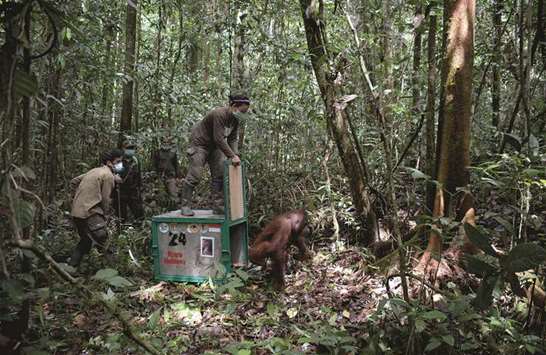And no wonder: She’s spent the last 24 hours in a cage - first on the back of a truck, then on a boat. Before that, it had been more than 10 years since this orangutan had seen the jungle.
The 40-kilogram animal now sits majestically atop a Bintangor tree in Borneo’s Bukit Baka Bukit Raya National Park watching three other apes also be released by the Borneo Orangutan Survival (BOS) animal rescue group. They come out of their cages and head for the trees.
However, there are fewer and fewer trees on Borneo and the neighbouring island of Sumatra. Over the past decade, more than 7 million hectares of rainforest here have been razed.
The orangutan’s natural habitat is steadily being replaced by palm oil plantations: Never-ending fields containing rows of 30-metre-tall palms with huge leaves and thousands of fruits.
Laws protecting the forests here are still very lax. A moratorium on the allocation of new plots of land has made little difference.
“You are put into prison when you kill a single orangutan. But if you burn down a whole rainforest and the orangutan is killed, nothing at all happens,” says Jamartin Sihite, director of BOS.
The destruction of the forests could genuinely mean the end for orangutans. In the middle of the 19th century, Borneo was almost completely covered by forest. Today, only around half of it remains.
The past few years have been particularly bad: A recent study estimated that the number of orangutans in Borneo has plunged by around 150,000 since 1999 to between 50,000 and 100,000. No one is sure of the exact number.
Behind the numbers are the personal tales of misery.
Agis, for example, was kept by a villager for seven months as a sort of replacement child. When she was rescued in 2006, she weighed just eight and a half kilograms, was suffering from malaria and typhus, and hardly had any hair left.
One of the BOS’s two rescue centres is at the Nyaru Menteng Arboretum on a piece of government land. It has been there for almost 20 years and today shelters around 450 orangutans.
It is hoped that most will return to the jungle one day.
“We are the biggest orangutan rehabilitation centre in the world,” says 52-year-old Jamartin. “But we hope one day to be the smallest.”
The rescue centres are financed by donations from all over the world. “Adopting” an orangutan costs about 30 dollars a month. BOS says it costs around 300 dollars a month to look after each ape.
The Swiss and the Danes are particularly generous, and Germany has also given money via a development ministry project.
A few months ago, BOS began working with the palm oil industry. The agricultural company Sawit Sumbermas Sarana (PTSSS) is contributing towards the purchase of an island where the orangutans can take part in a kind of jungle camp before they are released back into the wild.
Currently there are around 30 animals on the 20-square-kilometre island, which is about an hour-and-a-half drive away from the centre.
But the work is something of a Sisyphean task. Orangutans are disappearing at such a rate that they cannot be replaced.
The rescue centre continues on regardless. Last year it released 75 apes back into the wild, and this year plans to double that number.
Sometimes the animals are even flown back into the jungle with government helicopters, with the cage hanging from a rope beneath.
That can be dangerous for both parties. In December, a male orangutan attacked the cage and its carers after it had been released.
Before each ape is released, a chip is inserted in its neck with a battery that lasts for two years. It allows BOS to keep track of the animal as it moves through the forest.
BOS statistics give each orangutan an 85 per cent success rate - that means that for every 100 apes released back into the wild, 85 are still alive two years later. Seven of its orangutans have even had babies since being released.
Despite BOS’s success, there are people who think the efforts aren’t worth it. The environmental organization Borneo Futures believes BOS’s work distracts from the issue of habitat destruction.
Expert Michael Kruetzen, from the University of Zurich, says releasing animals back into the wild “basically makes sense.”
“But you have to track the animals for several years afterwards to see how they get on,” he says. “Or more bluntly put, to see if they actually survive.” – DPA

FREEDOM: Staff members from the animal rights group Borneo Orangutan Survival (BOS) release an orangutan into the wild.


